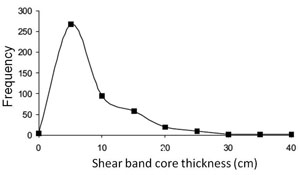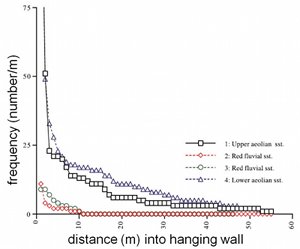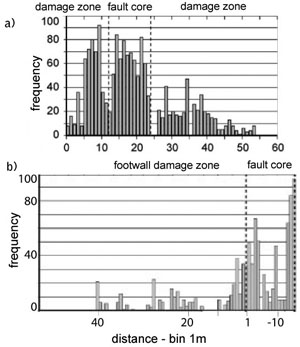| |||||||||
|
|
|||||||||
|
|
|||||||||
| Geostatistical Properties of Shear Band Zones | |||||||||
|
As summarized under thickness properties of deformation bands, single shear bands and compaction bands appear to have characteristic average thicknesses on the order of one millimeter to a couple centimeters, controlled primarily by grain size, porosity, lithology, and loading. However, thickness distribution of deformation band zones is quite different. In this case, the total thickness is controlled by the addition of new bands adjacent to the existing ones. For example, Aydin and Johnson (1978) reported a shear band zone thickness as large as 0.5 m including closely spaced, sub-parallel bands of as many as 100 or more in the Entrada and Navajo sandstones cropping out in the San Rafael Desert and Arches National Park, Utah. Shipton et al. (2005) measured shear band core thicknesses made up of many shear band faults in the same formations cropping out in the San Rafael Swell (Utah), which shows generally about 5 cm peak with the largest thickness of about 40 cm (Figure 1). Large faults with multiple slip surfaces may have zones two orders of magnitude greater.
Of course, the thickness of damage zones surrounding shear band cores are many times greater than the thickness of fault cores. Here three examples, all from Utah, are presented, one in Figure 2 from a normal fault with 15 m offset in the San Rafael Desert (Fossen et al., 2007), and the other two in Figure 3 from the Moab Fault with about 30 m and 160 m total offsets, west of the town of Moab (Davatzes and Aydin, 2003). A large portion of the offsets is due to shear bands and the associated slip surfaces. However, sheared joints also contributed to the total slip. Note that the damage zone thicknesses vary according to the lithology. Also, damage zones have a higher frequency of band per meter and are wider for the faults with larger offsets.
| |||||||||
| Types of Geostatistical Properties of Shear Band Zones: | |||||||||
| Shear Band Zone Length - Displacement Scaling | |||||||||
| Reference: |
|||||||||
| Aydin, A., Johnson, A.M., 1978 Davatzes, N.C., Aydin, A., 2003 Fossen, H., Schultz, R.A., Shipton, Z.K., Mair, K., 2007 Shipton, Z.K., Evans, J.P., Thompson, L.B., 2005 |
|||||||||
|
Readme | About Us | Acknowledgement | How to Cite | Terms of Use | Ⓒ Rock Fracture Knowledgebase |
|||||||||


